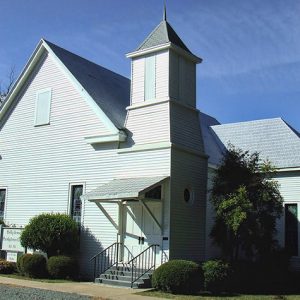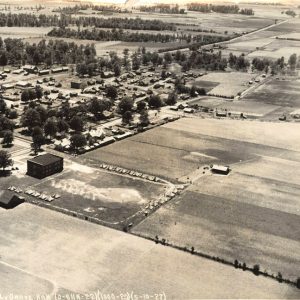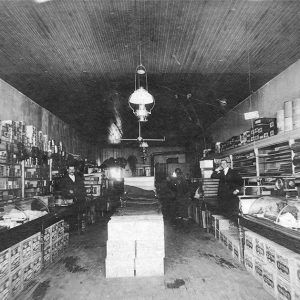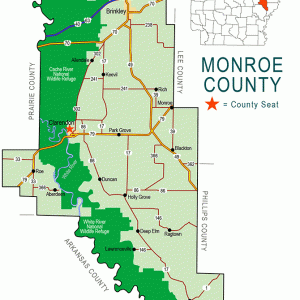calsfoundation@cals.org
Holly Grove (Monroe County)
| Latitude and Longitude: | 34º35’45″N 091º11’59″W |
| Elevation: | 180 feet |
| Area: | 1.00 square miles (2020 Census) |
| Population: | 460 (2020 Census) |
| Incorporation Date: | August 2, 1876 |
Historical Population as per the U.S. Census:
|
1810 |
1820 |
1830 |
1840 |
1850 |
1860 |
1870 |
1880 |
1890 |
1900 |
|
– |
– |
– |
– |
– |
– |
– |
161 |
353 |
391 |
|
1910 |
1920 |
1930 |
1940 |
1950 |
1960 |
1970 |
1980 |
1990 |
2000 |
|
536 |
977 |
741 |
755 |
761 |
672 |
840 |
754 |
675 |
722 |
|
2010 |
2020 |
|
|
|
|
|
|
|
|
|
602 |
460 |
|
|
|
|
|
|
|
|
Holly Grove is a well-preserved Delta community. Its business district is included on the National Register of Historic Places, as are three houses and one church in the city.
Henry Augustus Fay received a land grant for the region that would become Holly Grove on November 15, 1836. The rich land of the area drew several settlers who established plantations to grow cotton and other crops. The name of the settlement is drawn from thickets of holly trees native to the area. The plantation community was a suburb of Lawrenceville (Monroe County), which was the county seat until 1857, when the seat was moved to Clarendon (Monroe County).
The creation of the Arkansas Central Railroad in 1872 brought prosperity to Holly Grove even as Lawrenceville dwindled to a ghost town. John Smith and James Kerr platted the new city of Holly Grove. D. B. Renfro opened the first store in the city, which was followed by Kerr, Robley, & Co. The city was incorporated in 1876. By 1890, the city had seven general stores, a drugstore, a grocery, a restaurant, a livery stable, a cotton gin, a grist mill, a machinists’ shop, a Masonic lodge, at least three churches, two physicians, and an undertaker. It also had a two-story school house. The central building in the city was the railroad depot.
Churches and schools were racially segregated in Holly Grove, as in most of Arkansas at that time. In March 1897, a white storeowner refused to serve an African-American woman in his store, leading to a boycott of his business by the black community, led by the ministers of their churches. Holly Grove had two newspapers for white readers: the Holly Grove Star, which failed after a few years of publication, and the Holly Grove Leader. It also had a newspaper for the black community, the Arkansas Banner.
The Bank of Holly Grove was established in 1903. It lasted for more than 100 years, surviving even the Depression, but was purchased by the First National Bank of Eastern Arkansas in 2005. A factory manufacturing railroad ties was established around 1910. A theater opened in 1920, and a gas station opened in 1927. The Flood of 1927 devastated the city, as 2,321 of its citizens fled to higher ground, to be cared for in an American Red Cross camp. However, the city survived the flood, and the business district around the railroad depot continued to thrive. Rice displaced cotton as the principal crop of the region during the twentieth century.
Even into the 1950s, Holly Grove flourished, with bands playing in downtown establishments that offered beer and dancing. Meanwhile, railroads diminished in importance as automobile traffic increased. In the present day, Interstate 40 crosses northern Monroe County more than twenty miles north of Holly Grove. State Highways 17 and 86 intersect in Holly Grove, but they do not host nearly as many travelers as the interstate. The railroad tracks have been removed, and the depot was sold to local interests. The school district was consolidated into the Clarendon School District. The Holly Grove elementary school continued to be used by the district until the building was destroyed by fire in December 2006.
The city celebrated its centennial in 1976, coupled with the nation’s bicentennial. Three years later, the twenty surviving buildings of Holly Grove’s downtown district were listed on the National Register of Historic Places. In the following years, the Abramson house, the James Walls house, the Lair house, and the Presbyterian church were also added to the National Register. Along with its historic structures and other private dwellings, Holly Grove also has a hardware store, a division of the Helena Chemical Company, and several churches. The city is served by a small municipal airport located to the south. The airport has one runway and shelters for single-engine aircraft, used largely for crop dusting.
For additional information:
Goodspeed Biographical and Historical Memoirs of Eastern Arkansas. Chicago: Goodspeed Publishing Company, 1890.
Jensen, Van. “Blaze Ravages Holly Grove’s Last School.” Arkansas Democrat-Gazette, December 17, 2006, pp. 1B, 12B.
Kuczynski, Terri L. Monroe County. Charleston, SC: Arcadia Publishing, 2009.
Steven Teske
Butler Center for Arkansas Studies
 Holly Grove Presbyterian
Holly Grove Presbyterian  Holly Grove Refugees
Holly Grove Refugees  Lambert Store
Lambert Store  Monroe County Map
Monroe County Map 



I’m looking to see Holly Grove become a thriving community again in the near future. I want to see a multi-cultural group of people living and bringing about major historical changes to the city of Holly Grove. Visionaries are what is needed for growth and change!